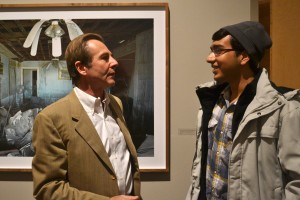By Christopher Squier, squierch@grinnell.edu
Robert Polidori, the photographer whose work currently hangs throughout the Faulconer Gallery, gave perhaps the most eccentric speech of the Gallery’s recent history last Tuesday.
Although his photographs in Faulconer, among which he stood during his speech, examine the aftermath of disasters like Hurricane Katrina and the Chernobyl nuclear disaster, his talk barely touched on these topics. Moreover, he did not speak about his artwork, his experiences capturing the photographs or anything directly related to his work in the gallery.
Shirking what would seem to be his responsibility in coming to Grinnell—to provide his own interpretation of either his art or artistic practice—Polidori instead embarked on a both torturous and tortured explanation-cum-saga of his particularly strange life. His longwinded anecdotes did provide some sort of material with which to frame his work and personal philosophies in making it, albeit by insulting the entire recent history of art and offending a number of audience members.
Although the topic of Polidori’s talk was generally elusive, composed of tangents continuously leading to further and less relevant tangents, the substance seemed to be a distrust of words and—as a professed Catholic atheist, he let us in on a secret that there wasn’t, in the beginning, the Word, but just fire and rocks—and a variety of formative aesthetic shocks.
These aesthetic shocks included the precision and “magic” of growing up around jewelers, Italian religious images, the music of Bob Dylan, Mathew Brady’s Civil War photographs and various movies such as Michael Snow’s film 1967 Wavelength.
Through his inability to either master or pay for a variety of artistic media, having disliked his own attempts at painting and finding film too expensive, Polidori apparently settled on film photography as his specialty.
His subsequent progression through various cities and job positions led to the creation of many wonderful photographs and an array of headstrong opinions—his first of the night being his comparison of the Union in the American Civil War to the Nazis.
The one opinion that seemed to stick and leave people pleasantly interested was his discussion of film photography in comparison to digital photography.
“Film is made to remember and digital is made to forget,” Polidori said.

The gist seemed to be that the proliferation of digital imagery, along with the process of constantly taking photos, lends the medium a tendency to be processed quickly, consumed and thrown away or forgotten. His own medium of film photography, on the other hand, is better aligned with memory, because the process of editing and spending a significant amount of time on one image creates a more personal connection with that image. In addition, the process of updating digital images as technology changes formats makes it impossible to hold onto forever.
Polidori was wooed into using a tripod, rather than using a handheld camera, through a peculiar fascination. The word tripod has roots in the Roman myth of the Oracle at Delphi, who sat in a cave inhaling the fumes of a certain drug and would babble nonsensical prophesies to an interpreter. The three-legged seat on which she sat was called a tripod long before the invention of the camera provided another use for it. The mythological connection piqued his interest in the tripod, it seemed.
Overall, it was a strangely amusing and unfocused talk, leaving one unsure whether Polidori had just forgotten to prepare a speech or genuinely thought his life story was a worthwhile topic for the hour-plus lecture.
He warned us against the risk of becoming a homebody in the digital age, and took a number of questions, which mostly turned into an uncompromising argument between optimistic and pessimistic views of the world.
One of my favorite quotes from Polidori was about his experiences after photographing one of the disaster sites: “I came back from it, like, depressed.”




























































